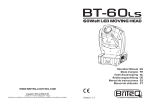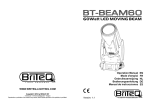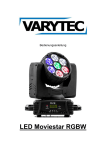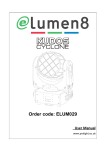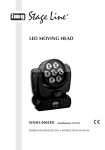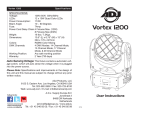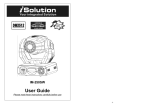Download (PRO LIGHT) iMvoe 350SR USER MANUAL - 05 05 2014
Transcript
User Manual Please read the instruction carefully before use CONTENTS 1. Safety Instruction....................................................................................................2 2. Technical Specifications ..........................................................................................3 3. How To Set The Unit ...............................................................................................5 3.1 Control Panel.....................................................................................................5 3.2 Main Function ...................................................................................................6 3.3 Home Position Adjustment .............................................................................13 4. How To Control The Unit ......................................................................................15 4.1 Master/Slave Built In Pre-‐program Function ..................................................15 4.2 Easy CA-‐8 Controller .......................................................................................16 4.3 DMX Controller ...............................................................................................16 4.4 DMX512 Configuration ...................................................................................17 5. DMX 512 Connection ............................................................................................20 6. Troubleshooting....................................................................................................21 7. Fixture Cleaning ....................................................................................................21 1 1. Safety Instruction WARNING Please read the instruction carefully which includes important information about the installation, usage and maintenance. Please keep this User Guide for future consultation. If you sell the unit to another user, be sure that they also receive this instruction booklet. Unpack and check carefully there is no transportation damage before using the unit. Before operating, ensure that the voltage and frequency of power supply match the power requirements of the unit. It’s important to ground the yellow/green conductor to earth in order to avoid electric shock. The unit is for indoor use only. Use only in a dry location. The unit must be installed in a location with adequate ventilation, at least 50cm from adjacent surfaces. Be sure that no ventilation slots are blocked. Disconnect main power before replacement or servicing. Make sure there are no flammable materials close to the unit while operating as it is fire hazard. Use safety cables when fixing this unit. DO NOT handle the unit by its head only, always carry by its base. Maximum ambient temperature is Ta: 40 degrees C. DO NOT operate it where the temperature is higher than this. Unit surface temperature may reach up to 75 degrees C. DO NOT touch the housing with bare-‐hands during its operation. Turn off the power and allow about 15 minutes for the unit to cool down before replacing or serving. In the event of a serious operating problem, stop using the unit immediately. Never try to repair the unit by yourself. Repairs carried out by unskilled people can lead to damage or malfunction. Please contact the nearest authorized technical assistance center. Always use the same type spare parts. DO NOT touch any wire during operation as high voltage may cause electric shock. Warning: To prevent or reduce the risk of electrical shock or fire, do not expose the unit to rain or 2 moisture. The housing and lenses must be replaced if they are visibly damaged. Caution: There are no user serviceable parts inside the unit. Do not open the housing or attempt any repairs yourself. In the unlikely event your unit may require service, please contact your nearest dealer. Installation: The fixture should be mounted via its Omega Quick Release Clamp bracket. Always ensure that the unit is firmly fixed to avoid vibration and slipping while operating and make sure that the structure to which you are attaching the unit is secure and is able to support a weight of 10 times of the fixtures weight. Always use a safety cable that can hold 12 times of the weight of the fixture when installing. The equipment must be installed by professionals. It must be installed in a place where is out of the reach of people and no one can pass by or under it. 2. Technical Specifications Constructions: Stylish design with fire retardant plastic housing Excellent ventilation for reliable operation Rotating Gobo Wheel: 6 rotating and changeable gobos plus open Static Gobo Wheel: 7 fixed gobos plus open Color Wheel: 8 colors plus white 3 facet prism, rotating prism Electric Focus Pan/Tilt: Pan/Tilt: 540°/270° 3 Automatic Pan/Tilt position correction Easy calibration and maintenance by magnetic home positioning Control: 3 operation control modes: DMX, Master/Slave Mode, Sound Active mode DMX channel modes: 15/16CH Blue/White LCD Display for easy navigation Manually adjustable beam angle: 12° ~ 17° 0~100% smooth dimming and variable strobe speeds Data In/Out: 5-‐PIN XLR sockets RDA: Remote DMX addressing, DMX address can be remotely set up by universal controller Specification: Power Voltage: AC 100~240V, 50/60Hz Power Consumption: 138W Power Cable Daisy Chains: 8 Fixtures Max. (230V, 50Hz) 4 Fixtures Max. (120V, 60Hz) Light Source: 1 x 60W white LED Dimension: 292 x 169 x 425mm Weight: 9Kgs 4 3. How To Set The Unit 3.1 Control Panel 1. Display: To show the various menus and the selected functions LED: 2. DMX On DMX input present 3. MASTER On Master Mode 4. SLAVE On Slave Mode 5. SOUND Flashing Sound activation 6. Button: MENU To select the programming functions DOWN To go backward in the selected functions UP To go forward in the selected functions ENTER To confirm the selected functions 7. MAINS IN: PowerCon connection from main power supply 8. MAINS OUT: PowerCon loop connection for main power supply to the next unit 9. Only For Remote Control: Connects to optional CA-‐8 to control the unit in Stand by, Function and Strobe/Blackout modes 5 10. Fuse (T 3.15A): Protects the unit from over-‐voltage or short circuit 11. DMX IN: DMX512 link, use 3-‐pin XLR cable to link the unit and the DMX controller 12. DMX OUT: DMX512 link, use 3-‐pin XLR cable to link the next unit and output DMX signal 3.2 Main Function To select any of the given functions, press the MENU button until the required function is showing on the display. Select the function by pressing the ENTER button and the display will blink. Use the DOWN/UP buttons to change the mode. Once the required mode has been selected, press the ENTER button to setup, to go back to the functions without any change press the MENU button again. Press and hold the MENU button for about one second or wait for one minute to exit the menu mode. The main functions are shown overleaf: 6 7 DMX Address To select the DMX Address, press the ENTER button to show DMX ADDRESS on the display. Use the DOWN/UP buttons to adjust the address from 001 to 512. Once the address has been selected, press the ENTER button to setup, to go back to the functions without any changes press the MENU button again. Press and hold the MENU button for about one second or wait for one minute to exit the menu mode. Channel Mode To select the Channel Mode, press the ENTER button to show CHANNEL MODE on the display. Use the DOWN and UP buttons to select the 15Chan (15 Channel) or 16Chan (16 Channel) mode. Once the mode has been selected, press the ENTER button to setup, to go back to the functions without any change press the MENU button again. Press and hold the MENU button for about one second or wait for one minute to exit the menu mode. Show Mode To select the Show Mode, press the ENTER button to show SHOW MODE on the display. Use the DOWN and UP buttons to select the Show 1, Show 2 or Show 3, Show 4 Mode. Once the mode has been selected, press the ENTER button to setup, to go back to the functions without any change press the MENU button again. Press and hold the MENU button for about one second or wait for one minute to exit the menu mode. Split Colour To select the Split Colour, press the ENTER button to show SPLIT COLOR on the display. Use the DOWN and UP buttons to select the Yes (Split color mode) or No (Normal). Once the mode has been selected, press the ENTER button to setup, to go back to the functions without any change press the MENU button again. Press and hold the MENU button for about one second or wait for one minute to exit the menu mode. Slave Mode To select the Slave Mode, press the ENTER button to show SLAVE MODE on the display. Use the DOWN and UP button to select the Slave 1 or Slave 2 mode. Once the mode has been selected, 8 press the ENTER button to setup, to go back to the functions without any change press the MENU button again. Press and hold the MENU button for about one second or wait for one minute to exit the menu mode. Black Out To select the Black Out, press the ENTER button to show BLACK OUT on the display. Use the DOWN and UP buttons to select the Yes (blackout) or No (normal) mode. Once the mode has been selected, press the ENTER button to setup, to go back to the functions without any change press the MENU button again. Press and hold the MENU button for about one second or wait for one minute to exit the menu mode. Sound State To select the Sound State, press the ENTER button to show SOUND STATE on the display. Use the DOWN and UP buttons to select the On (Sound Mode On) or Off (Sound Mode Off). Once the mode has been selected, press the ENTER button to setup, to go back to the functions without any change press the MENU button again. Press and hold the MENU button for about one second or wait for one minute to exit the menu mode. Sound Sense (Sensitivity) To select the Sound Sense, press the ENTER button to show SOUND SENSE on the display. Use the DOWN and UP buttons to adjust the sound sensitivity from 0 to 100, press the ENTER button to setup, to go back to the functions without any change press the MENU button again. Press and hold the MENU button for about one second or wait for one minute to exit the menu mode. Pan Inverse To select the Pan Inverse, press the ENTER button to show PAN INVERSE on the display. Use the DOWN and UP buttons to select the Yes (pan inversion) or No (normal) mode. Once the mode has been selected, press the ENTER button to setup, to go back to the functions without any change press the MENU button again. Press and hold the MENU button for about one second or wait for one minute to exit the menu mode. 9 Tilt Inverse To select he Tilt Inverse, press the ENTER button to show TILT INVERSE on the display. Use the DOWN and UP buttons to select the Yes (tilt inversion) or No (normal) mode. Once the mode has been selected, press the ENTER button to setup, to go back to the functions without any change press the MENU button again. Press and hold the MENU button for about one second or wait for one minute to exit the menu mode. Back Light To select the Back Light, press the ENTER button to show BACK LIGHT on the display. Use the DOWN and UP buttons to select the On (LED display on) or Off (LED display off) mode. Once the mode has been selected, press the ENTER button to setup, to go back to the functions without any change press the MENU button again. Press and hold the MENU button for about one second or wait for one minute to exit the menu mode. Gobo Focus To select the Gobo Focus, press the ENTER button to show GOBO FOCUS on the display. Use the DOWN and UP buttons to adjust the value from 0 to 255, press the ENTER button to setup, to go back to the functions without any change press the MENU button again. Press and hold the MENU button for about one second or wait for one minute to exit the menu mode. Gobo2 Focus To select the Gobo 2 Focus, press the ENTER button to show GOBO 2 FOCUS on the display. Use the DOWN and UP buttons to adjust the value from 0 to 255, press the ENTER button to setup, to go back to the functions without any change press the MENU button again. Press and hold the MENU button for about one second or wait for one minute to exit the menu mode. Function Delay To select the Function Delay, press the ENTER button to show FUNCTION DELAY on the display. Use the DOWN and UP buttons to select the No Delay or 1S Delay, 2S Delay, 3S Delay (wait for 1/2/3 seconds before these functions of 15/16CH are activated/deactivated). Once selected, press the ENTER button to setup, to go back to the functions without any change press the MENU 10 button again. Press and hold the MENU button for about one second or wait for one minute to exit the menu mode. Dimmer Calibration To select the Dimmer Calibration, press the ENTER button to show DIMMER CALIBRAT. on the display. Use the DOWN and UP buttons to adjust the dimmer from 50 to 100, press the ENTER button to setup and store, to go back to the functions without any change press the MENU button again. Press and hold the MENU button for about one second or wait for one minute to exit the menu mode. Auto Test To select the Auto Test, press the ENTER button to show AUTO TEST on the display and the unit will run a self-‐test. To go back to the functions press the MENU button again. Press and hold the MENU button for about one second or wait for one minute to exit the menu mode. Temprature To select the Temp, press the ENTER button to show TEMP. on the display and the display will show the temperature of the unit. To go back to the functions press the MENU button again. Press and hold the MENU button for about one second or wait for one minute to exit the menu mode. Fixture Time To select the Fixture Time, press the ENTER button to show FIXTURE TIME on the display and the display will show the number of working hours of the fixture. To go back to the functions press the MENU button again. Press and hold the MENU button for about one second or wait for one minute to exit the menu mode. Firmware Version To select the Firmware Version, press the ENTER button to show FIRMWARE VERSION on the display and the display will show the version of software of the unit. To go back to the functions press the MENU button again. Press and hold the MENU button for about one second or wait for 11 one minute to exit the menu mode. Defaults To select the Defaults, press the ENTER button to show the DEFAULTS on the display. Use the DOWN and UP button to select the Confirm? Yes or Confirm? No. Once the Confirm? Yes has been selected, use the DOWN and UP button to select the PRO defaults or AUTO defaults. PRO Defaults: For professional users, detailed explanation as followings: Channel Mode 16Chan Split Color Mode Yes Slave Mode Slave 1 Black Out Sound State Sound Sense 90 Pan Inverse No Tilt Inverse No Back Light Off Function Delay Yes Off 3S Delay AUTO Defaults: Mostly automatic mode, for non professional users, detailed explanation as followings: Channel Mode 15Chan Split Color Mode No Slave Mode Slave 1 Black Out Sound State On Sound Sense 90 Pan Inverse No Tilt Inverse No Back Light On Function Delay 3S Delay No (Notice: Other settings are NOT changed while choosing Defaults Setting!) Then press the ENTER button and the corresponding functions will set to defaults setting, to go back to the functions without any change press the MENU button again. Press and hold the MENU button for about one second or wait for one minute to exit the menu mode. Reset To select the Reset, press the ENTER button to show RESET on the display, and all channels of the unit will return to their standard position. To go back to the functions press the MENU button 12 again. Press and hold the MENU button for about one second or wait for one minute to exit the menu mode. 3.3 Home Position Adjustment Press the MENU button into menu mode, then press the ENTER button for about 3 seconds into offset mode to adjust the home position. Select the function by the ENTER button. Use the UP and DOWN buttons to choose the submenu, press the ENTER button to store and automatically return to the last menu. Press the MENU button to exit. PAN OFFSET —Pan home position adjustment To select the Pan Offset, press the ENTER button to show PAN OFFSET on the display. Use the DOWN and UP buttons to adjust the value from -‐127 to 127, press the ENTER button to store. Press the MENU button to exit. TILT OFFSET —Tilt home position adjustment To select the Tilt Offset, press the ENTER button to show t TILT OFFSET on the display. Use 13 the DOWN and UP buttons to adjust the value from -‐127 to 127, press the ENTER button to store. Press the MENU button to exit. COLOR OFFSET —Color home position adjustment To select the Color Offset, press the ENTER button to show COLOR OFFSET on the display. Use the DOWN and UP buttons to adjust the value from -‐127 to 127, press the ENTER button to store. Press the MENU button to exit. GOBO 1 OFFSET —Gobo1 home position adjustment To select the Gobo 1 Offset, press the ENTER button to show GOBO 1 OFFSET on the display. Use the DOWN and UP buttons to adjust the value from -‐127 to 127, press the ENTER button to store. Press the MENU button to exit. R GOBO 1 OFFSET —Gobo1 rotation home position adjustment To select the R Gobo 1 Offset, press the ENTER button to show R GOBO 1 OFFSET on the display. Use the DOWN and UP buttons to adjust the value from -‐127 to 127, press the ENTER button to store. Press the MENU button to exit. GOBO 2 OFFSET —Gobo2 home position adjustment To select the Gobo 2 Offset, press the ENTER button to show GOBO 2 OFFSET on the display. Use the DOWN and UP buttons to adjust the value from -‐127 to 127, press the ENTER button to store. Press the MENU button to exit. PRISM OFFSET —Prism home position adjustment To select the Prism Offset, press the ENTER button to show PRISM OFFSET on the display. Use the DOWN and UP buttons to adjust the value from 0 to 255, press the ENTER button to store. Press the MENU button to exit. R PRISM OFFSET —Prism rotation home position adjustment To select the R Prism Offset, press the ENTER button to show R PRISM OFFSET on the display. Use the DOWN and UP buttons to adjust the value from -‐127 to 127, press the ENTER button to store. Press the MENU button to exit. FOCUS OFFSET —Focus home position adjustment 14 To select the Focus Offset, press the ENTER button to show FOCUS OFFSET on the display. Use the DOWN and UP buttons to adjust the value from 0 to 255, press the ENTER button to store. Press the MENU button to exit. 4. How To Control The Unit There are three ways to control the unit: 1. Master/slave built-‐in preprogram function 2. Easy CA-‐8 controller 3. Universal DMX controller You do not need to turn the unit off when you change the DMX address, the new DMX address setting will take effect immediately. Every time you power the unit on, it will move all the motors to their ‘home’ position and you may hear some movement noises for about 20 seconds. After that the unit will be ready to receive DMX signal or run the built in programs. 4.1 Master/Slave Built In Preprogrammed Function By linking the units in master/slave connection, the first unit will control the other units to give an automatic, sound activated, synchronized light show. This function is very good when you want an instant show. You have to set the first unit in master mode Show Mode and select show 1, show 2, show 3 or show 4 mode. Its DMX input jack will have nothing plugged into it, and Its master LED will be constantly on and sound LED will flash to the music. The other units will be set in slave mode and select Slave 1 (normal) or Slave 2 (2 light show) mode, Their DMX cables plugged into the DMX input jacks (daisy chain) and the slave LED lights will constantly on. 2-‐light show In slave mode, Slave 1 means the unit works normally and Slave 2 means 2-‐light show. In order to create a great light show, you can set Slave 2 on the second unit to get contrast movement to each other, even if you have two units only. 15 4.2 Easy Controller The easy remote control is used only in master/slave mode. By connecting to the 1/4” microphone jack of the first unit, you will find that the remote controller on the first unit will control all the other units in Stand by, and Mode selection. Stand By Blackout the unit Function 1. Sync. Strobe 2. Async strobe 3. Sound Strobe Show 1-‐4 1. Press to select color 2. Hold to select gobo Mode Sound (LED OFF) Show (LED Slow Blinking) LED ON 4.3 DMX Controller By using a universal DMX controller to control the units, you will need to set DMX address from 1 to 512 so that the units can receive DMX signal. Press the MENU button up to when the DMX Address is showing on the display. Pressing ENTER button and the display will blink. Use DOWN and UP buttons to change the DMX512 address. Once the address has been selected, press the ENTER button to setup, to go back to the functions without any change press the MENU button again. Hold and press the MENU button about one second or wait for one minute to exit the menu mode. Please refer to the following diagram to address your DMX512 channel for the first 4 units: Channel mode Unit 1 Address Unit 2 Address Unit 3 Address Unit 4 Address 15 channels 1 16 31 46 16 channels 1 17 33 49 16 4.4 DMX512 Configuration 15 Channels Mode: 17 16 Channels Mode: 18 19 5. DMX 512 Connection 1. If you using a controller with a 5 pin DMX output, you need to use a 5 to 3 pin adapter-‐cable. 2. The last units DMX cable has to be terminated with a 120 ohm 1/4W resistor between pin 2(DMX-‐) and pin 3(DMX+) of a 3-‐pin XLR-‐plug and plug it in the DMX-‐output of the last unit. 3. Connect the units together in a `daisy chain` by XLR plug from the output of the unit to the input of the next unit. The cable can not branched or split to a `Y` cable. The DMX output and input connectors are “pass-‐through” to maintain the DMX circuit, when one of the units power is disconnected. 4. Each fixture unit needs to have an address set to receive the data sent by the controller. The address number is between 0-‐511 (usually 0 & 1 are equal to 1). 5. 3 pin XLR connectors are more popular than 5 pin XLR. 3 pin XLR: Pin 1: GND, Pin 2: Negative signal (-‐), Pin 3: Positive signal (+) 5 pin XLR: Pin 1: GND, Pin 2: Negative signal (-‐), Pin 3: Positive signal (+), Pin 4/Pin 5: Not used. 20 6. Troubleshooting Following are a few common problems that may occur during operation. Here are some suggestions for easy troubleshooting: A. The unit does not work, no light and the fan does not work 1. Check the connection of power and main fuse. B. Not responding to DMX controller 1. DMX LED should be on. If not, check DMX cables to see if linked properly. 2. If the DMX LED is on and no response to the controller, check the address settings and DMX polarity. 3. Try another DMX controller. 4. Check if the DMX cables run near or run alongside to high voltage cables that may cause interference. C. Some units don’t respond to the easy controller 1. You may have a break in the DMX cabling. Check the LED for the response of the master/ slave mode signal. 2. Wrong DMX address in the unit. Set the correct address. D. No response to the sound 1. Make sure the unit is not set in DMX mode. 2. Check microphone by tapping it 3. Make sure the fixture is not set into Blackout mode 7. Fixture Cleaning The cleaning must be carried out periodically to optimize light output. Cleaning frequency depends on the environment in which the fixture operates: moist, smoky or particularly dirty surrounding can cause greater accumulation of dirt on the fixture. Clean with soft cloth using normal glass cleaning fluid. 21 Always dry the parts carefully. Clean the external optics at least every 30 days. Declaration of Conformity We declare that our products (lighting equipments) comply with the following specification and bears CE mark in accordance with the provision of the Electromagnetic Compatibility (EMC) Directive 89/336/EEC. EN55103-‐1: 2009 ; EN55103-‐2: 2009; EN62471: 2008; EN61000-‐3-‐2: 2006 + A1:2009 + A2:2009; EN61000-‐3-‐3: 2008. & Harmonized Standard EN 60598-‐1:2008 + All:2009; EN 60598-‐2-‐17:1989 + A2:1991; EN 62471:2008; EN 62493: 2010 Safety of household and similar electrical appliances Part 1: General requirements 22 Innovation, Quality, Performance 23

























